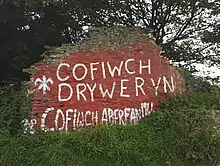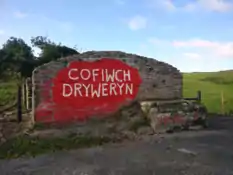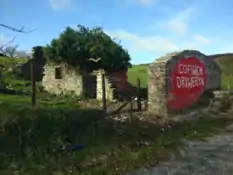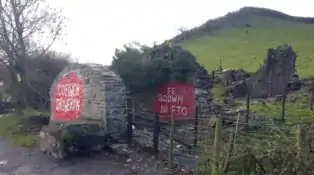Cofiwch Dryweryn
Cofiwch Dryweryn (English: "Remember Tryweryn") or Y Wal Cofiwch Dryweryn (English: "The Remember Tryweryn Wall") is a graffitied stone wall near Llanrhystud, Ceredigion, Wales. Author and journalist Meic Stephens originally painted the words onto the wall of a ruined cottage in the early 1960s following the decision by the Liverpool City Council to flood the Tryweryn Valley to create the Llyn Celyn reservoir.[1] Due to its prominent location, stark message, and history of repeated vandalism, the wall has become an unofficial landmark of mid Wales. The phrase "Cofiwch Dryweryn" has itself become a prominent political slogan for Welsh nationalism, appearing on T-shirts and banners, and as replica murals.[2][3][4][5]

History
Background
In July 1957, following parliamentary approval, Liverpool City Council pursued the flooding of the Tryweryn Valley without the consent of Welsh authorities and against the wishes of most Welsh Members of Parliament. The council also failed to respond to formal planning inquiries presented by residents to explain their concerns with the proposal. Despite protests in Liverpool, London, and Wales, the valley was flooded in 1965, and several centuries-old communities such as Capel Celyn were lost.[6]
Creation
In 1962 and 1963, Meic Stephens, a Welsh author and scholar, had painted numerous slogans across the South Wales Valleys. In response to the upcoming flooding of the Tryweryn Valley, Stephens decided to paint "Cofiwch Tryweryn" (sic), Welsh for "Remember Tryweryn", onto a rock. He drove around Wales with his friend Rodric Evans to find a suitable location, after which he spent fifteen to twenty minutes painting the message. The wall Stephens used is part of a ruined cottage named Troed-y-Rhiw. Because the original Cofiwch Tryweryn is grammatically incorrect, subsequent restorations of the wall have repainted the message correctly as Cofiwch Dryweryn.[3][7]
Cultural impact
The flooding of Tryweryn itself was a pivotal moment in twentieth century Welsh nationalism, with militant groups and Plaid Cymru, the Welsh nationalist party, gaining increased support in the following years. As such the phrase Cofiwch Dryweryn has become a prominent maxim of Welsh nationalism, easily recognisable to people on both sides of the debate.[8]
In a 2006 interview, Stephens stated that he "didn't choose the spot for any particular reason" and that he didn't expect it to turn out any more iconic than his other slogans. The impact and notoriety of the message has been highlighted by the numerous occasions the wall has been the subject of vandalism and restorations, and the continuing debate regarding its protection as a Welsh cultural landmark.[9]
Vandalism and protection
_Llanrhystud.jpg_01.jpg.webp)
_Llanrhystud.jpg.webp)
The message has been both vandalised and restored on numerous occasions. In 1991, two schoolboys, Rhys ap Hywel and Daniel Simkins, painted the wall white and repainted the original letters in black. In doing so they misspelled "Tryweryn" as "Trywerin". Ap Hywel later stated in interviews that his Welsh teacher at Ysgol Gyfun Gymunedol Penweddig knew he was responsible as he initialled the painting, but she only admonished him for the spelling error. Consequently, Ap Hywel repainted the wall adding "Sorry Miss!".[10][11]
In 2003, the Ceredigion Urdd repainted the phrase onto the wall as part of a show commemorating the events of Tryweryn at Theatr Felinfach.[12] By 2007, a section of the wall had fallen and the writing had been replaced with stencilled white letters on a red background. In May 2008, the message was altered to Angofiwch Dryweryn (English: "Forget Tryweryn"; correct spelling Anghofiwch).[13] The monument was again defaced in April 2010, prompting a spokesperson for the Welsh Government to state their disappointment with the defacement after recent attempts to preserve the wall.[2] Due to the wall's history of vandalism and its state of decay, many people wanted the wall to be designated as a national monument as a means of protection. Despite the launch of a fundraising campaign to achieve this goal, the wall did not receive a designation, and it was further vandalised in 2013 and 2014.[14][3]
In 2017, the words Cofiwch Aberfan 1966 ("Remember Aberfan 1966") were added underneath the original message, referring to the Aberfan disaster. After the wall was restored in 2018, it was defaced again in February 2019, though it was restored again the next day following a social media campaign. The incident saw renewed calls for its protection, with parallels drawn with Banksy's recent anti-air pollution work Season's Greetings in Port Talbot being protected from vandalism. Most notably, Bethan Sayed, Plaid Cymru's spokesperson for Heritage, Welsh Language and Sport, raised the issue with the Welsh government.[15][16][17]
On 11 April 2019, i'r Gâd! ("to battle" or "to arms!") was added at the base of the mural, with the top section of the wall containing the word Cofiwch (remember) being demolished the next day. The wall was rebuilt and repainted on 13 April by a group of eight volunteers.[18][19] In the subsequent days, a second wall next to the original was painted with Fe Godwn Ni Eto ("We'll rise again") and the campaign organisation YesCymru reported that over fifty new Cofiwch Dryweryn murals had been painted throughout Wales. In London, the message was displayed on a banner at that month's London Marathon, in addition to signs with the message being displayed at Downing Street and Whitehall. By the end of April, it was estimated that over a hundred murals with the message had been painted globally.[20][21][22][23] Dyfed–Powys Police responded to the vandalism by placing a CCTV camera at the site, stating that they were treating the incident as a hate crime.[24][25] The trig point on Fan Gyhirych in the Brecon Beacons also bears the slogan.[26]
On 30 June 2020, it was reported that the memorial had once again been vandalised, this time with a Nazi swastika and a white power symbol being painted over the text.[27] The Senedd member for Ceredigion, Elin Jones reported the next day that the mural had been restored.[28]
External links
See also
References
- "Tryweryn: The drowning of a village". BBC Timelines. Retrieved 13 April 2019.
- "'National landmark' Cofiwch Dryweryn is defaced". BBC. 29 April 2010.
- Morgon, Sion (24 February 2014). "Vandals deface famous Cofiwch Dryweryn memorial". Wales Online. Retrieved 5 August 2018.
- "How an act of anti-Welsh vandalism is fuelling the push for independence". The Guardian. 26 April 2019.
- "How Welsh independence burst into the mainstream". Western Mail (Wales). 26 April 2019.
- Addley, Esther (7 August 2019). "Welsh graffiti wall to get charity protection following vandalism". The Guardian. Retrieved 7 August 2019.
- Stephens, Meic. "Cofiwch Tryweryn?". BBC (in Welsh). BBC Cymru fyw.
- Bomford, Andrew (19 October 2005). "The lake that stirred nationalism". BBC. BBC.
- Jones, Ifan Morgan (Autumn 2006). "Meic Stephens Interview". Golwg magazine (in Welsh): 18.
- "Cofiwch Dryweryn mural vandalised again". Nation.Cymru. Retrieved 12 April 2019.
- "Fi di duw: Rhys ap Hywel". Youtube (in Welsh). Rondo Media.
- "Y theatr gymunedol sy'n plesio pawb" (in Welsh). Western Mail. 6 December 2003.
- "Anger over memorial wall attack". BBC. 13 May 2008.
- Morgon, Sion (13 October 2010). "Bid to preserve the iconic 'Cofiwch Dryweryn' wall". Wales Online. Retrieved 5 August 2018.
- "Drowned Tryweryn village slogan replaced by Elvis". BBC. BBC News. 3 February 2019.
- Owens, David. "Famous monument to flooded village vandalised and replaced with 'Elvis'". Wales Online.
- "Dyn ifanc yn teimlo 'dyletswydd' i adfer cofeb Tryweryn" (in Welsh). 4 February 2019.
- Walford, Jessica (13 April 2019). "Famous monument to flooded village destroyed by 'mindless vandals'".
- "'Cofiwch Dryweryn' drowned village graffiti smashed". BBC News. 13 April 2019.
- Whelan, Zara (30 April 2019). "From America to Downing Street – how Cofiwch Dryweryn has gone across the Atlantic in response to mural attacks".
- Thomas, Michelle (26 April 2019). "How an act of anti-Welsh vandalism is fuelling the push for independence".
- Harris, Robert (26 April 2019). "People in Wales have painted more than 50 Cofiwch Dryweryn tributes around the country".
- Zara Whelan & Eryl Crump (16 April 2019). "The amazing way Wales has hit back at the Cofiwch Dryweryn mural vandals". Retrieved 16 April 2019.
- Hemming, Jez. "Volunteers defy vandals to rebuild Tryweryn monument less than 24 hours after it was partly demolished". Retrieved 14 April 2019.
- "Cofiwch Dryweryn memorial attack treated as hate crime". Retrieved 15 April 2019.
- "Photograph of trig point". Retrieved 12 August 2020.
- "Cofiwch Dryweryn mural vandalised with swastika and white power symbol". Nation Cymru. 30 June 2020.
- https://www.bbc.co.uk/news/uk-wales-53247629


